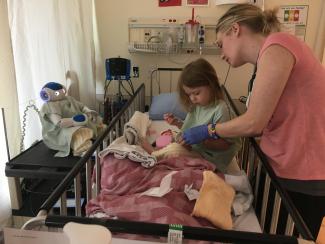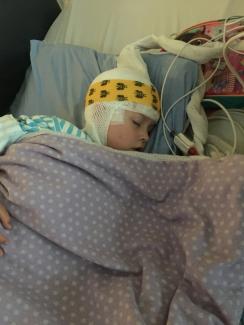Read how Kristine and Ellie’s story began here.

Hi. My name is Kristine, and my daughter’s name is Ellie. This is our story.
In July 2014, Ellie was diagnosed with neonatal sepsis immediately after birth, and spent 19 days in the neonatal intensive care unit. She survived, but as Ellie is getting older, we are seeing some very concerning behaviours, learning disabilities, physical limitations, and social anxieties.
In February 2017, at 2 and half years old, Ellie began experiencing episodes of severe screaming, pain, and disorientation, with no identifiable trigger. She went from being a great sleeper to being up multiple times a night. She began repeating words and phrases, and experiencing extreme pain and swelling in her hands and feet. She will tell me she has ‘sparkles on her feet’, where her toes and finger tips are red and hot, and the rest of her hand is freezing. She has trouble in the classroom with focus and attention, frequently staring off and having trouble focusing with her eyes. She has a one-on-one aid due to these symptoms, especially the disorientation, so she is kept safe while at school. Cold, stress (positive or negative), and exercise worsens the symptoms. She has difficulty regulating her emotions and at times is violent and uncontrollable. She also suffers from severe fatigue at times and does not have the energy/stamina that a child her age should have.
The last few years have been beyond difficult for our family and Ellie especially. Ellie severely lacks confidence when she isn’t feeling well and is very dependent and has severe separation anxiety. She lacks coping skills not only to her pain, but also minor non-pain related adversity.
Not knowing what is happening to her and not knowing how severe the next episode may be is extremely stressful. We have a hard time planning any family holiday or even just daily activities at times. To see your child experiencing such horrible pain and struggles on a daily basis is heartbreaking. It is a helpless feeling to know you have no way to help your child and take her pain away. Although a diagnosis will not solve all of her problems, it will definitely help provide her with the medical treatment and support at home and in the community that she desperately needs and deserves.

In 2016 (2 years after Ellie’s birth and diagnosis with a Streptococcus infection) I had strep throat yet again and was being treated with antibiotics. 7 days into my course of antibiotics I became violently ill with a high fever, vomiting, and severe abdominal pain. I recognized the symptoms immediately as they were almost identical to the symptoms I had after Ellie was born. I was taken to emergency and spent 6 days admitted at our local hospital on intravenous antibiotics with a suspected re-occurrence of sepsis. I was praised for my quick thinking in recognizing the signs of sepsis, and had a faster recovery because I was treated quickly.
I’ve had multiple tests which ruled out brain tumors and multiple sclerosis but like Ellie, we are still investigating what could be causing these symptoms. I have inquired about Post-Sepsis Syndrome for both Ellie and myself, but due to the lack of research around this diagnosis, we have not been able to find any physician or specialist who agrees that this could be a possibility.
Before becoming sick, I did not know the magnitude of sepsis. I also didn’t know the magnitude of Post-Traumatic Stress Disorder. After 5 years I still have nightmares of what we went through. I have guilt over not recognizing how sick I was, and for not allowing myself to become attached to my newborn baby, fearing that I wouldn’t be taking her home from the hospital. I am petrified of strep throat when it makes its rounds each year, and unfortunately it happens frequently in our house. I would love to see an emotional support program for parents of any child who has spent time in the NICU. Once we were discharged, we had weekly neonatal checks for Ellie back at our local hospital, but we did not receive any support for the emotional trauma that we experienced during that time. Social workers visited us in the hospital, but as anyone who has been through a critical, life-threatening illness likely knows, you are in fight-or-flight mode. Discussions around emotions and feelings didn’t happen for us at that time. I think it could have simply been the fact that if I didn’t talk about the possibility that we may lose her, that it wouldn’t be real.
I am thankful to have this opportunity to be able to share our story and advocate for more education around sepsis - how we can recognize it, how we can treat it, and how we can prevent it. The path to prevention is education and the path to healing is support.
If our story can touch just one person and let them know they are not alone in their journey with sepsis, then it has served its purpose.
